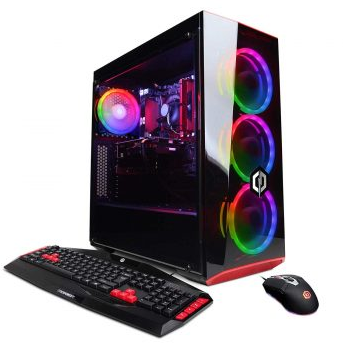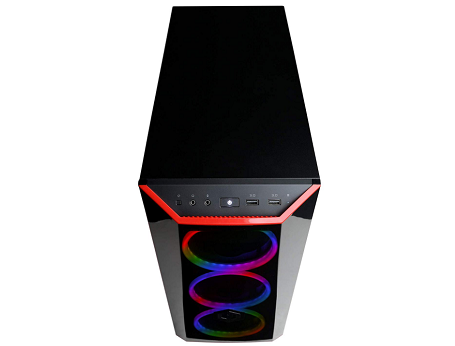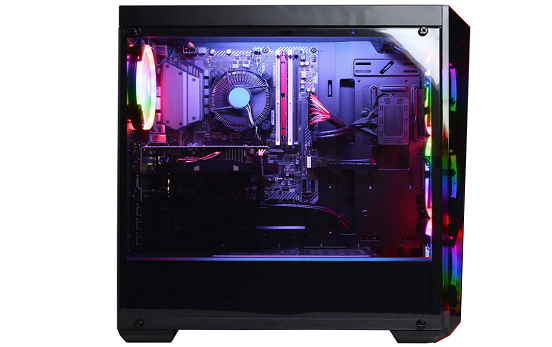CyberpowerPC Gamer Xtreme VR GXiVR8060A7 Review and Specs. The original CYBERPOWERPC Gamer GXiVR8060A6 was just one of our all-time favorite budget gaming PCs. We loved it for its expandable chassis, powerful internals, and unique exterior design. That means the 2019 CyberpowerPC Gamer Xtreme VR GXiVR8060A7 some big shoes to fill.
The most recent version of CyberPowerPC’s Gamer Xtreme features an Intel Core i5-9400F processor, an Nvidia GeForce GTX 1660 graphics card, 8GB of RAM, and a 120GB SSD + 1TB hard drive. All for an entry-level price. Let’s see how it stacks up again the most recent and budget-friendly pre-built gaming PCs on the market– and most importantly, let’s find out how it earns that sweet pricetag.
CyberpowerPC Gamer Xtreme VR GXiVR8060A7 Design
Measuring 18.5 x 7.9 x 17.9 inches, the Gamer shares a similar footprint to other boutique-built towers, like rival iBuyPower’s Trace 9220, mainstream manufacturer HP’s Omen Obelisk, and Dell’s Alienware Aurora R7. Compared to the Neuron’s option of a mini ITX board, the larger Intel B360 Chipset on the Gamer not only provides more space to add components, but is roomy enough for your hands to move when making upgrades.
The machine’s internal components are accessible through a removable side panel, that’s screwed by thumbscrews, top provide a tool-less way to access the insides. Once you remove the tinted glass panel, you have access to the motherboard, solid-state drive, RAM, and graphics card. The power supply and hard drive are housed behind the metal side panel on the opposite side.
With a tinted glass, the Gamer looks clean when powered off. When turned on, there’s a lot in the unit to keep you excited, ranging from the RGB backlighting throughout the case, to the liquid-cooed processor. Cable work is excellent, which keeps things tidy and helps with airflow.
Gaming & Virtual Reality
In addition to the Gamer’s strong processing performance, the unit’s entry-level GTX 1660 graphics keeps the unit firmly in the consideration of enthusiast gamers, who don’t need newer features like features like real-time ray tracing and deep learning super sampling (DLSS). Giving up these technologies to hit a lower price sounds like a winning strategy for Nvidia.
In fact, the TU116 GPU raises the question of just how low Nvidia is willing to go with its newest Turing architecture. The 1660 trims things further even opting for readily available GDDR5 instead of the newer GDDR6, along with fewer CUDA cores and few other elements, the result is exactly what you ‘d guess: a slightly slower but more affordable GPU for mainstream PCs
Getting more performance at a lower price and support for VR headsets is great. It benefits from some architectural enhancements, higher clockspeeds, and more shade cores, than last year’s GTX 1060 (6GB) GPU. The GPU at the heart of the GTX 1660 is the same as TU116 found in the 1660 Ti, only that two SMs have been disabled, in turn disabling 128 CUDA cores and 8 texture units.
On real-world gaming, it delivers impressive frame rates per second (fps) than its closest rivals, especially when played at 1080p. Assassin’s Creed: Odyssey played at 1080 (Very High Quality) yields 64fps, which is better than the Radeon RX Vega 56’s 62 fps, while the GTX 1060 maxes at 57 fps.
The same is replicated in The Witcher 3 Wild Hunt (57 fps, 54 fps, 48 fps) and Warframe (170 fps, 151 fps, 152 fps), respectively. Given that the GTX 1660 can render most contemporary games with modest graphics, like Civilization VI and Fortnite, at frame rates above 60 frames per second (fps), some gamers will indeed appreciate the smooth game play.
Ports
To keep up with its gaming pedigree, the Gamer ships with plenty of ports to hook all your favorite peripherals. The front ports, accessible on the top of the case, include two USB-A 3.0 ports, audio and headphone jacks, and a power button. Around the back, there’s an even more robust array of ports, including six USB ports, ethernet jack, two legacy PS/2 ports to accommodate your older mouse and keyboard connections, audio and headphone jacks, and video output ports, including DisplayPort and HDMI connections.
Since the Gamer tops with a GTX 1660 graphics instead of an upgraded RTX 2080 card, you won’t be finding a USB-C port here, making it less future-proof, but still an okay configuration for the price. Though the GTX 1660 delivers enough power to drive virtual reality headsets, its latest sibling the RTX 2080 includes a USB-C port, meaning it can take advantage of the single VirtualLink connecter. For now, you’ll have to do with multiple cables to drive your headset.
CyberpowerPC Gamer Xtreme VR GXiVR8060A7 Performance
Though CyberPowerPC bills the Gamer Xtreme as a gaming PC, it’s easy to envision small business owners and home users snagging it for productivity tasks given the machine’s options for high-end processors and graphics. Our upgraded reviews configuration ships with a 9th-generation Intel processor, but to keep the price more affordable, the Gamer tops out with an Intel Core i5-9400F rather than the high-end Core i9-9900K on the flagship iBUYPOWER Pro Trace 9240 unit.
The Core i5-9400F processor accumulates well against similar Core i5 and AMD Ryzen 7 systems, thanks to the chip’s 6 cores throttling at 2.9 GHz. The newer chip used here is a monumental upgrade over last year’s Core i5-8400 processors.
For daily computing tasks, using the Gamer Xtreme for web browsing, moderate photo-editing, and heavy productivity tasks, most consumers will appreciate the performance boost with the Gamer’s Core i5 processor. More intensive task, such as video encoding may require more time to complete, but its within the upper-range for budget desktop PCs.
Our unit features a speedy 120GB NVMe solid-state drive coupled with a larger 1TB hard drive to house larger files. While 120GB isn’t the best we’ve seen on a gaming PC, we still appreciate its presence at this price point, delivering fast 1,249 MB/sec read and 1,012 MB/s write speeds. Both drives and the 8GB RAM are easily upgradable should you find yourself requiring more space for your game files and other documents.
Our Opinion
The Gamer Xtreme GXiVR8060A7 is an attractive, powerful and affordable alternative to having build your own gaming PC from square one, but it’s not a PC without its own compromises. While the Gamer Extreme ships with the current processor and graphics card on the market, the unit can not be configured with the best available silicone. This is a compromise made to keep the cost at bay, and enthusiasts still have the choice of a more premium configuration in CyberPowerPC’s Gamer Xtreme Series.
Is there a better alternative?
As configured, the Gamer Xtreme is a competitively priced entry-level gaming PC. For a few hundred dollars more, you can grab the iBUYPOWER Trace 9220 that offers an overclockable Intel Core i7-8700K processor, a true Nvidia GeForce RTX 2070 (8GB) Turing graphics card, 16GB of RAM and a 240GB SSD + 1TB hard drive storage.
That’s if you’re willing to deepen your dive into your pockets. If not, both units– the Gamer Xtreme and Trace 9220 are more affordable in their respective categories (mid-range and entry-level), and offer the best value for both gamers and professional creatives.
Should you buy it?
Without the excessive need to build your own rig from scratch (you might end up spending more), you can ultimately depend upon the choices that CyberPowerPC made. That means you’re getting a handsomely designed, VR-ready system that packs ample performance to get you started.
Verdict
The CyberpowerPC Gamer Xtreme VR GXiVR8060A7 is an attractive, powerful and affordable alternative to having build your own gaming PC from square one, but it’s not a PC without its own compromises.
PROS
- Modern design with tempered glass side panel
- Competitive pricing
- Spacious interior for easy upgrades
CONS
- Lacks USB-C, Thunderbolt 3 ports



